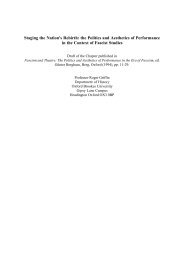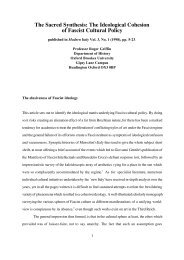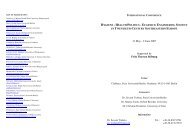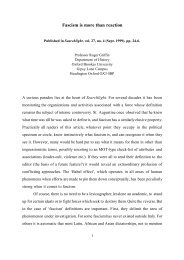Revolution from the Right: Fascism - School of Arts and Humanities ...
Revolution from the Right: Fascism - School of Arts and Humanities ...
Revolution from the Right: Fascism - School of Arts and Humanities ...
Create successful ePaper yourself
Turn your PDF publications into a flip-book with our unique Google optimized e-Paper software.
‘modernist anti-modernism’, 4 or ‘reactionary modernism’ 5 .<br />
4<br />
This chapter flies in <strong>the</strong> face <strong>of</strong> such ‘common sense’ by arguing that even if <strong>the</strong> radical<br />
right in general is ‘reactionary’, at least in its fascist manifestations it does indeed function as a<br />
evolutionary ideology. Or to quote <strong>the</strong> American academic Eugen Weber’s thoughtful essay on<br />
this topic: ‘fascism, too easily defined as counter-revolutionary, is not a counter-revolution, but<br />
a rival revolution: rival <strong>of</strong> [<strong>the</strong> communist one] which claimed to be <strong>the</strong> only one entitled to <strong>the</strong><br />
label...For <strong>the</strong> fascists, communism is not subversion attacking <strong>the</strong> established order, it is a<br />
competitor for <strong>the</strong> foundation <strong>of</strong> power.’ 6 Before a case can be made for this approach, however,<br />
it is necessary to clarify what we mean by two key words both <strong>of</strong> whose meaning is strongly<br />
contested by ‘experts’: ‘revolution’ <strong>and</strong> ‘fascism’.<br />
‘<strong>Revolution</strong>’ <strong>and</strong> ‘fascism’ as ideal types<br />
If <strong>the</strong> terms ‘revolution’ <strong>and</strong> ‘fascism’ are both conceptually fuzzy <strong>and</strong> value-laden, <strong>the</strong>n any<br />
discussion <strong>of</strong> <strong>the</strong>ir relationship risks being so subjective as to become pointless. The solution to<br />
such dilemmas, which are a recurrent feature <strong>of</strong> <strong>the</strong> human sciences, is to create an artificially tidy<br />
definition known in <strong>the</strong> social sciences as an ‘ideal type’. An ideal type has <strong>the</strong> same sort <strong>of</strong><br />
relationship to <strong>the</strong> empirical reality being defined as a stylized underground railway (subway)<br />
map has to <strong>the</strong> actual network <strong>of</strong> rails <strong>and</strong> stations it displays. 7 It does not tell you about <strong>the</strong><br />
characteristics <strong>of</strong> any one phenomenon, but singles out <strong>the</strong> things which all manifestations <strong>of</strong> one<br />
type <strong>of</strong> phenomenon have in common.<br />
‘<strong>Revolution</strong>’ can be used as an ideal type to refer to ‘a fundamental (structural) change<br />
which, while manifesting itself in a particular sphere <strong>of</strong> human activity, has radically innovative












